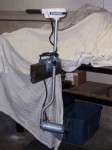No, the title does not mean I have gone a wee bit balmy. This article is about finding things but not on the beach. It is also not really about lighthouses, but does take place on, or near a lighthouse where my wife Karen and I were first stationed.
When I saw the photo below it brought back many memories of our first lighthouse at Pulteney Point, Malcolm Island.
Pulteney Point lighthouse is located between Port McNeil and Port Hardy on Vancouver Island, British Columbia (see map below). It is still manned.
In 1901 Finnish settlers made Malcolm Island their home – see a short version of the story here.

When we arrived at the lighthouse in 1969 there were still traces of the settlements visible in the woods between the lighthouse and the town of Sointula. Old buildings, parts of wharves, chimneys, rusting appliances and farm implements. One needed a boat to explore most of them as there were no usable trails through the woods – at least none that were usable now.
But out behind the lighthouse there was a trail leading into the woods along the beach on the northwest side leading to a small creek that flowed into the ocean where the lightkeepers used to pump water to the station for drinking water. Part way along the trail were a couple of old buildings we were told housed the early settlers.
Having explored many ruins and old townsites on Vancouver Island before moving onto the lights we thought we were pretty expert at finding old souvenirs, bottles, etc.
Armed with shovel, trowel and a few sacks we headed out one day to explore the ruins. We knew we were probably not the first ones to explore the site, but hoped that our expertise would prevail and we would find what they had not.
First, we had been told many years earlier, look for a garbage dump. By now that would have been overgrown, so we looked for any hump that was off to the side of the property and away from the main house.

We did find and excavate a couple of likely spots, but found nothing that resembled what we were looking for. We searched through both buildings – one a house, and the other outbuilding, probably a sauna – hey, it was a Finnish homestead, so why not?
After hours of searching we found one small Vaseline bottle which had turned purple in the sun. Heading home proudly with our find, we showed it off to the other family at the lighthouse.
View Larger Map (Pulteney Point lighthouse at the marker)
We completely forgot about the episode until about a year later when a boat with strangers arrived at the station. The two men and two women explained that they had been exploring the old Finnish homesteads for souvenirs and asked if it would be okay to look around out back as they had been told there was a homestead there as well.
Walter Tansky, the senior keeper, said there was no problem as all the property behind the lighthouse was Crown Land. I was wondering how long they would be there before they discovered that there was nothing significant there.
After a couple of hours they had not returned. I got curious and wandered back there to see what was taking so much of their time. Upon arriving at the site I saw that the floorboards had been torn up, and there was a pile of old bottles sitting off to one side.
How? Where? What . . .? I was speechless. Where did all these bottles come from?
So after getting over my shock, I asked some questions. It turns out they had found what they thought was the kitchen by probing. Probing involves the use of a spring steel probe about 1/4″ in diameter and about 4 feet long. It usually has a metal or wood T-handle. This is pushed into the earth to locate buried objects like metal and glass.
Under the floor in the kitchen they found most of the bottles. They assumed that a wood shelf had collapsed onto the rotten floor and carried its load of bottle with it. Some were broken, but most were in very good condition because they had not been moved since the early 1900s.
So this was not beachcombing, and I could not call it landcombing, but we sure did learn a lot about bottle scavenging.






